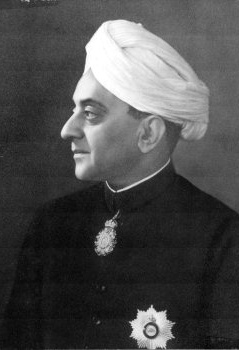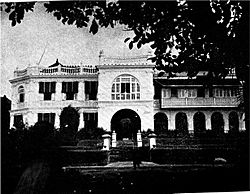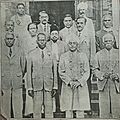C. P. Ramaswami Iyer facts for kids
Quick facts for kids
C. P. Ramaswami Iyer
|
|
|---|---|

Portrait of Ramaswami Iyer, The Hindu (1939)
|
|
| 8th Vice-Chancellor of Banaras Hindu University | |
| In office 1 July 1954 – 2 July 1956 |
|
| Appointed by | Rajendra Prasad |
| Preceded by | Acharya Narendra Dev |
| Succeeded by | Veni Shankar Jha |
| Diwan of Travancore | |
| In office 8 October 1936 – 19 August 1947 |
|
| Monarch | Sri Chithira Thirunal of Travancore |
| Preceded by | Muhammad Habibullah |
| Succeeded by | P. G. N. Unnithan |
| Member of the Executive Council of the Viceroy of India | |
| In office 1931–1936 |
|
| Monarch | George V of the United Kingdom, Edward VIII of the United Kingdom |
| Governor-General | Freeman Freeman-Thomas, 1st Marquess of Willingdon |
| Law Member of the Executive Council of the Governor of Madras | |
| In office 1923 – 10 March 1928 |
|
| Premier | Raja of Panagal, P. Subbarayan |
| Governor | Freeman Freeman-Thomas, 1st Marquess of Willingdon, Sir Charles George Todhunter (acting), George Goschen, 2nd Viscount Goschen |
| Succeeded by | T. R. Venkatarama Sastri |
| Advocate-General of Madras Presidency | |
| In office 1920–1923 |
|
| Governor | Freeman Freeman-Thomas, 1st Marquess of Willingdon |
| Preceded by | S. Srinivasa Iyengar |
| Succeeded by | C. Madhavan Nair |
| Personal details | |
| Born | 13 November 1879 Wandiwash, Madras, British India (present-day Vandavasi, Tiruvannamalai district, Tamil Nadu, India) |
| Died | 26 September 1966 (aged 86) London, United Kingdom |
| Nationality |
|
| Political party | Indian National Congress |
| Spouse | Seethamma |
| Children |
|
| Residences | The Grove, Madras |
| Alma mater | Presidency College, Madras |
| Occupation | Lawyer |
| Profession | Attorney-General, Statesman |
| Signature | |
Sir Chetput Pattabhiraman Ramaswami Iyer (1879–1966), often called Sir C. P., was an important Indian lawyer, administrator, and politician. He held many key positions during his life. He was the Advocate-General of Madras Presidency from 1920 to 1923. He also served as a Law Member in the Executive Council of the Governor of Madras (1923–1928) and the Viceroy of India (1931–1936).
His most famous role was as the Diwan of Travancore from 1936 to 1947. During this time, he brought about many social and administrative changes. However, he is also remembered for how he dealt with a major uprising and his strong views on Travancore becoming independent. He resigned in 1947 after someone tried to assassinate him.
In his early career, he was part of the Indian National Congress. He received titles like Knight Commander of the Indian Empire in 1926 and Knight Commander of the Star of India in 1941, but he gave them back when India became independent in 1947. He also represented India at the League of Nations. Later in life, he worked with many international groups and Indian universities. Sir C. P. passed away in 1966 in the United Kingdom when he was 86 years old.
Contents
Early Life and Schooling
Chetpet Pattabhiraman Ramaswami Iyer was born on November 13, 1879, in Wandiwash, a town in North Arcot. His father, C.R. Pattabhirama Iyer, was a well-known judge.
C. P. went to Wesley College High School in Madras. He had a very strict upbringing. He later studied at Presidency College, Madras. In college, he excelled in English, Sanskrit, and Mathematics, winning several awards. He graduated with top honors from Madras Law College.
Even though C. P. wanted to be an English professor, his father wished for him to become a lawyer. So, C. P. chose a career in law. During his college breaks, he spent time in the Mysore kingdom with the Diwan, Sir K. Seshadri Iyer, who inspired him greatly.
Career as a Lawyer
In 1903, C. P. started his law career. He quickly became known as a skilled lawyer. He won over 300 cases and was even offered a position as a judge at the Madras High Court, but he turned it down.
In 1920, he was appointed Advocate-General of Madras by Governor Lord Willingdon. As a lawyer, C. P. handled many important cases, including the famous Besant Narayaniah case.
Role in India's Freedom Movement
Early in his life, C. P. admired Gopal Krishna Gokhale. He worked with Annie Besant to organize the Home Rule League and became its vice-president. In 1917, he became the Secretary of the Indian National Congress. He also edited Besant's newspaper, New India, and campaigned for her release when she was imprisoned.
However, C. P. later moved away from the Indian Independence movement. He disagreed with Mahatma Gandhi's ideas, especially about the Swadeshi (using Indian-made goods) and Non-Cooperation movements.
Member of the Governor's Council
In 1920, C. P. was named the Advocate-General of Madras Presidency. He helped introduce important laws like the City Municipalities Act. In 1923, he joined the executive council of the Governor of Madras. Here, he was in charge of law and order, police, public works, irrigation, ports, and electricity.
As a council member, C. P. started the construction of the Pykara Dam and the Mettur Dam on the Cauvery river. The Pykara project helped industries grow in Coimbatore, while the Mettur project brought water to farms in Tanjore and Trichy. He also worked to improve the ports of Cochin, Visakhapatnam, and Tuticorin.
C. P. also played a role in the Devadasi Abolition Bill. This bill aimed to stop the practice of dedicating young girls to temples.
From 1926 to 1927, he was India's representative at the League of Nations in Geneva. By 1931, he was a Law Member for the Government of India. He attended the Third Round Table Conference in London in 1932. In 1933, he was the only Indian delegate at the World Economic Conference. The next year, he helped draft a constitution for the state of Kashmir.
Diwan of Travancore
In 1931, C. P. helped Chithira Thirunal become the Maharaja of Travancore. The Viceroy of India agreed, but only if C. P. would advise the young ruler. C. P. served as a legal and constitutional adviser from 1931 to 1936. In 1936, Maharaja Chithira Thirunal asked C. P. to become the Diwan of Travancore, a position he held for ten years.
Temple Entry Proclamation
On November 12, 1936, Maharaja Chithira Thirunal issued the groundbreaking Temple Entry Proclamation. This allowed Hindus of all castes, including Dalits (formerly called untouchables), to enter Hindu temples in the state. This was a huge step for social equality. Although some conservative groups opposed it, Mahatma Gandhi and other reformers praised this decision.
Economic and Industrial Growth
Under C. P.'s leadership, Travancore saw great progress in industry. He invited the Indian Aluminium Company to build a factory in Aluva. He also set up India's first fertilizer plant, Fertilizers and Chemicals of Travancore Ltd. (FACT). C. P. also established plants to make cement and titanium dioxide. Factories for plywood, rayon, and aluminum cables were also opened.
By the time C. P. left his role in 1947, the state's income had grown four times.
Water and Power Projects
C. P. wanted to build a hydroelectric power project on the Periyar river. Despite opposition, he successfully argued for it, leading to the Pallivasal hydro-electric project. He also started other irrigation projects, including the Pechipara Hydro-electric Scheme and the Periyar Game Sanctuary.
Other Important Changes
C. P. did a lot of work to improve the Vivekananda Rock at Cape Comorin and built guest-houses in Kanyakumari. He also restored the Padmanabhapuram Palace and expanded the Trivandrum Art Gallery.
In 1937, C. P. started the University of Travancore, serving as its Vice Chancellor. In 1940, Travancore became the first state in India to take over road transport. The first cement highway in India was built between Trivandrum and Kanniyakumari, covering 88 kilometers.
That same year, capital punishment was ended, and adult franchise (the right to vote for all adults) was introduced. He was also the first to appoint a woman as a District Judge, Mrs. Anna Chandy. C. P. also started a midday meal program to encourage poor children to attend school.
In 1941, the British gave him the title of Knight Commander of the Star of India (KCSI).
Punnapra-Vayalar Uprising
In October 1946, a large uprising happened in the Alleppey region. The Travancore police and army took strong action to control it. This event, though short-lived, led to some improvements in Travancore's administration.
Travancore's Independence
When the United Kingdom decided to leave India in 1947, the Maharaja of Travancore wanted to declare his state independent. C. P. supported this idea, and Travancore declared independence on June 18, 1947.
However, India did not accept Travancore's independence. Talks began between C. P. and Indian representatives. It is believed that C. P. himself preferred more freedom for Travancore rather than full independence, and an agreement was almost reached for Travancore to join India.
On July 25, 1947, during a concert, someone tried to assassinate C. P. He survived with stab wounds. After recovering, he quickly helped Travancore join the Indian Union.
Later Years and Contributions
After leaving his role as Diwan of Travancore, C. P. traveled widely. He visited Brazil, Argentina, Peru, Mexico, and the United States, where he gave talks and met with important people, including US President Harry S. Truman.
From 1954 to 1956, he served as the Vice Chancellor of Banaras Hindu University. From 1955, he also became Vice Chancellor of Annamalai University, making him the first Indian to hold this position at two universities at the same time.
In 1953, C. P. was appointed to the Press Commission of India. He also led an Indian universities delegation to China. He served on various important committees, including the University Grants Commission and the Hindu Religious Endowments Commission.
Death
In September 1966, C. P. went to England to do research for a book. On September 26, 1966, he passed away suddenly in London at the age of 86. News of his death was reported in The Times, which called him "one of the outstanding Indians of his day." Many important Indian leaders also offered their condolences.
Legacy and Impact
C. P. is remembered for his skills as a lawyer, administrator, and visionary. He is credited with helping to industrialize Madras Presidency. He was also seen as someone who believed in equality, being the first high-caste Hindu lawyer to accept a Dalit, N. Sivaraj, as his junior.
Under his leadership, Travancore became the first princely state to end capital punishment, introduce free and compulsory education, and connect to the rest of India by air. M. G. Ramachandran, a former Chief Minister of Tamil Nadu, noted that C. P. was the first to introduce a midday meal scheme in Travancore.
His greatest achievement is considered to be the Temple Entry Proclamation, which allowed Dalits to enter Hindu temples for the first time. He did this despite threats to his life.
C. P. was also known for his charity work and the institutions he helped create. After his death, The C. P. Ramaswami Aiyar Foundation was set up to promote traditional arts and crafts. He was a supporter of arts and music.
The English writer Somerset Maugham described C. P. as a friendly and intelligent person who spoke excellent English.
Criticisms
While many praised C. P. as a modern reformer, some criticized him. He faced criticism for how he handled the problems of the Travancore National and Quilon Bank. He was also criticized for his strong actions against the Punnapra-Vayalar revolt in 1946. This uprising led to an assassination attempt on him.
Initially, C. P. was also seen as someone who wanted Travancore to remain separate from the Indian Union, which was a controversial stance at the time.
Family Life
In 1895, at the age of 16, C. P. married Seethamma. She passed away in 1930. They had three sons: C. R. Pattabhiraman, C. R. Venkata Subban, and C. R. Sundaram. His son, Pattabhiraman, was active in the Indian Independence Movement and later became a Deputy Minister and Minister of Industries in India.
Images for kids



